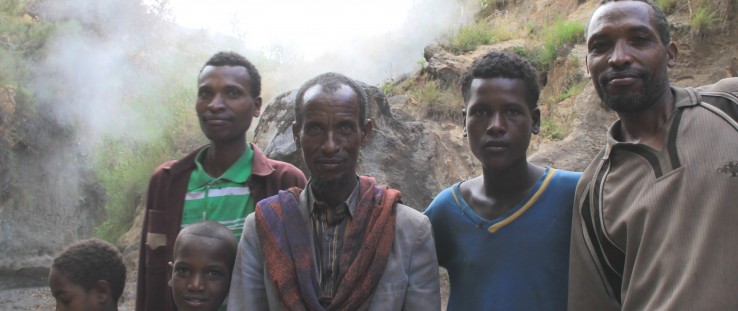 Badhasso Dubee, center, with other Corbetti residents
Robert Sauers, USAID
Badhasso Dubee, center, with other Corbetti residents
Robert Sauers, USAID
 Badhasso Dubee, center, with other Corbetti residents
Robert Sauers, USAID
Badhasso Dubee, center, with other Corbetti residents
Robert Sauers, USAID
In 2008, when the price of potash—a type of salt and key component of manufactured fertilizers—began to skyrocket around the world, Nejib Abba Biya, an Ethiopian-born Canadian entrepreneur, explored the possibilities of opening a mine to harvest this product in his native country.
When his company engineers conducted a feasibility study in 2009, however, they discovered that a power shortage would prevent the project from moving forward. That is when Nejib trained his sights on geothermal energy as a reliable, renewable power source. Ethiopia has vast, yet underutilized, reserves not only of geothermal energy, but natural gas as well.
“Wind farms work in the evening when there is wind. Solar works during the day. Hydropower plants work effectively when you have rain and the rivers are full,” said Nejib, who has founded and run several mining and technology companies in Canada and Africa. “But a geothermal energy plant works all the time.”
Fast forward five years and Nejib is now an architect of a deal between Reykjavik Geothermal, a U.S.-Icelandic private developer, and the Government of Ethiopia to build and operate the largest geothermal facility in Africa. The 1,000-megawatt facility will be built by Reykjavik Geothermal in partnership with Rift Valley Geothermal, a local business where Nejib is the CEO.
Once completed, the project will generate enough electricity to power two million homes. If used exclusively for residential use, this would result in enough electricity for 30 million people who currently do not have access to power. The initial agreement to negotiate a deal was announced this past September. Currently, the Government of Ethiopia and Reykjavik Geothermal are conducting final negotiations.
“This project will set a new benchmark for large-scale projects financed by the private sector and will help Ethiopia unleash its full energy potential,” said Reykjavik Geothermal CEO Gudmunder Thoroddsson.
This initial project agreement marks a milestone for Power Africa, an initiative announced in June 2013 by U.S. President Barack Obama that aims to leverage U.S. expertise in energy technologies, private sector transactions, and policy and regulatory reform to support sub-Saharan African nations' energy plans. Power Africa facilitates complex energy transactions like the Corbetti project by providing technical assistance or financing.
In Ethiopia alone, two-thirds of its citizens have no electricity, and with an annual per capita income of just $471, very few can afford a generator. For the average person, that means cooking food on an open fire and not having light for their children to study.
What Is Geothermal Energy?
Heat is a form of energy, and geothermal energy is comprised of the heat from within the earth. Most resources of geothermal energy are in active volcanic regions. The energy ranges from hot springs found just below the surface to the extremely high temperatures of molten rock called magma. Generally, geothermal power is produced by pumping water into the earth’s crust and then conveying the heated water or steam back to the surface. Geothermal energy has the potential to play a significant role in moving the world toward a cleaner, more sustainable energy system.
Opening the Door to Private Investment
“In Africa, one of the biggest hurdles to economic development is the lack of access to electricity, something that Power Africa is addressing,” said USAID/Ethiopia Mission Director Dennis Weller. “It makes perfect sense that Ethiopia is one of the Power Africa countries. With its abundant renewable energy resources and its geographic location, Ethiopia can export power to neighboring countries to help reduce poverty and expand economic growth throughout the region.”
Power Africa strives to double the number of people with access to power in sub-Saharan Africa by unlocking the substantial wind, solar, hydropower, natural gas and geothermal resources. For the first five years, the U.S. Government has committed more than $7 billion in financial support and loan guarantees in addition to the coordinated support and expertise of 12 U.S. Government agencies. Power Africa is also targeting Kenya, Tanzania, Nigeria, Ghana and Liberia.
The geothermal project in Ethiopia is exactly the type of project envisioned by the initiative.
Located at Corbetti Caldera (a caldera is a volcanic crater) in the central Rift Valley of Ethiopia, the $4 billion project will be built in two stages—the first 500 megawatts should be operational by 2018 and an additional 500 megawatts by 2021. The site is located approximately 240 kilometers south of the nation’s capital, Addis Ababa.
“Early on, Power Africa identified Corbetti as a priority transaction that could showcase the initiative's innovative model: combining private sector expertise and investment with U.S. Government tools to mitigate risk and build local government expertise,” added Weller.
USAID is working with Government of Ethiopia officials to adopt industry standards that will help attract investors, reduce the tremendous risk that comes with a massive project like this, and lead to other power projects long after Power Africa investment ends.
Nejib says that private investors and commercial lenders are expected to be the major financial sources for the Corbetti project. “Obama’s Power Africa initiative facilitates the process of making funds available from U.S. financial institutions, but other banks will be involved in the project,” he added.
“The Corbetti agreement is a significant signal to the private sector and international investors that the Ethiopian energy sector is looking at new ways to meet its power requirements. This is also a critical objective of Power Africa: working in collaboration with African governments to institute appropriate reforms to create the right enabling environment for private sector activities,” said Weller. “The Corbetti deal has blown the doors open for private investment in Ethiopia’s power sector.”
Nejib understands what the project means for his homeland. “Ethiopia is one of the fastest growing economies in the world. We have the potential. If we concentrate and work hard, we can achieve much more than this. We are talking about becoming a middle-income country, but we can go further if we utilize our resources,” he said.
Potential for Growth in Energy
The Corbetti project will be part of the Ethiopian Government’s plan to generate 30,000 megawatts of electric power from renewable resources. According to Thorleifur Finnsson, the head of project development for Reykjavik Geothermal, the project will be one of the lowest cost and most technologically advanced geothermal facilities in the world. Electricity generated from the new power plant will be used for domestic consumption and exported to neighboring countries.
The Ethiopian Government is negotiating a 25-year deal to buy energy from the Corbetti plant. “This project will make Ethiopia’s power generation more reliable, secure, flexible, and competitive to industries, hydro processing and other service and commercial sector users,” said Mihret Debebe, former CEO of the Ethiopian Electric Power Corporation.
The plant will employ hundreds of people for the construction phase and several hundred full-time staff after completion. Reykjavik Geothermal will initially drill several kilometers below the earth’s surface. This requires massive amounts of water and the company is prepared to install pipes to bring water 15 kilometers from Lake Awasa. Excess water will be available to the community—water that is now far away.
“We will endeavor to give hope and tangible assistance to the immediate community,” said Nejib.
For residents living in the Caldera, their only sources of water are Lake Awasa and a small amount of condensation from steam dripping off tree and plant roots.
Mohammed Dasse lives with his large family in the Caldera. Every three days, a family member takes 12 hours to travel 15 kilometers to Lake Awasa, gather water, and journey the 15 kilometers back home.
Badhasso Dubee is also one of 10,000 people living in the Corbetti Caldera who could benefit from the project. A farmer with three wives and 30 children, he said, “I have never had electricity in my life. Nobody in Corbetti has it. We cook with wood because we can’t get gas, but the wood gives off smoke that is dangerous to breathe. At night, there is little we can do because there is no light.”
Both Mohammed and Badhasso say they are looking forward to benefiting from the Corbetti project.
Will Electricity Generate an Economic Renaissance?
“Ethiopia is blessed with all sources of renewable energy sources, but, geothermal is by far the one that could also create spin-off industries such as manufacturing for its parts, tourism and hospitality, cosmetic and skin care pharmaceuticals and so forth, as we witnessed in Iceland,” said Nejib. “This geothermal project will create several hundred jobs, including high skilled jobs. Last but not least, the transfer of skill and knowledge from this project could propel further growth of the industry.”
Clean energy, like that from the Corbetti project, can power Ethiopia’s growth by bringing new businesses, new jobs and improving quality of life, while leapfrogging old generation technologies that pollute the environment, harm public health and contribute to global warming.
“To become a middle-income country, we must develop sufficient and sustainable energy from renewable sources, for it is impossible to bring about growth without energy,” said Ethiopian Prime Minister Hailemariam Desalegn in October 2013 while inaugurating the 120-megawatt Ashegoda wind farm project in northern Ethiopia.









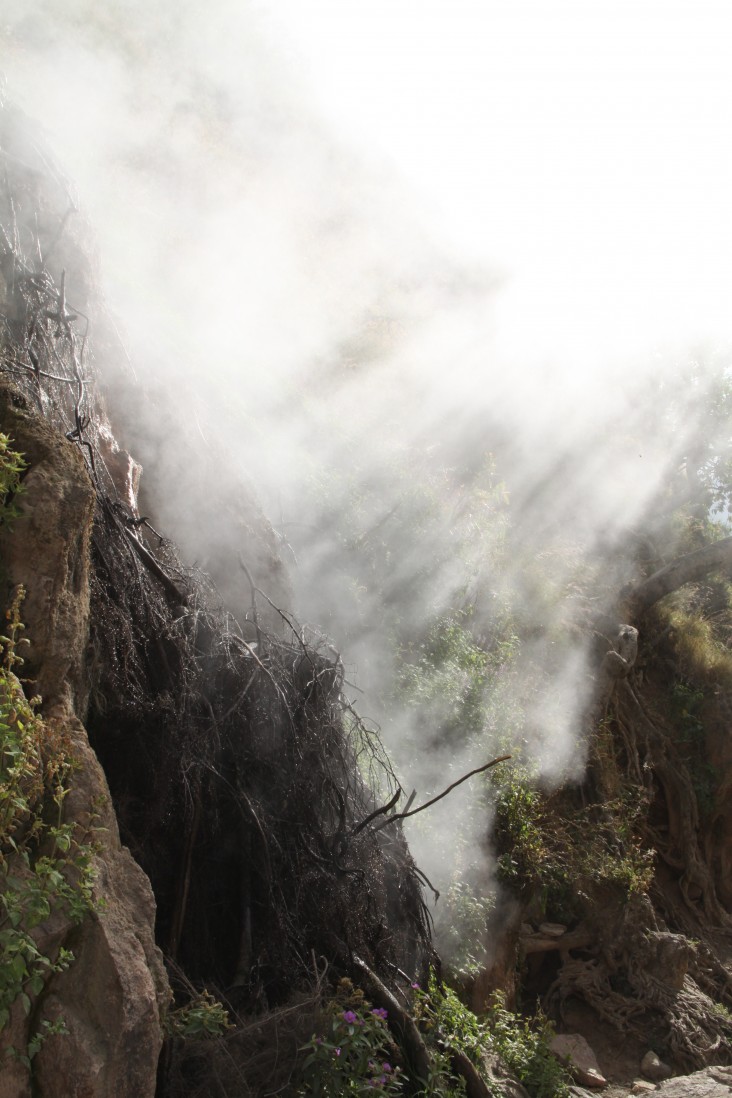
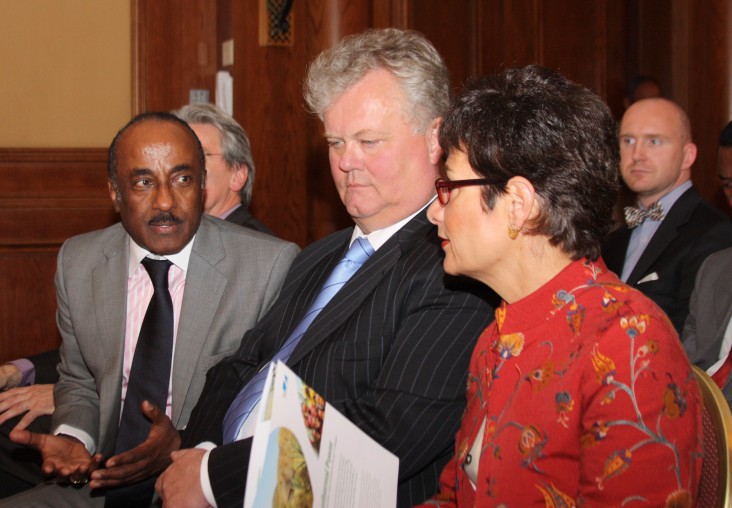
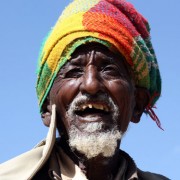
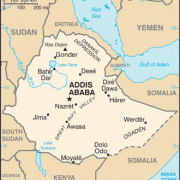
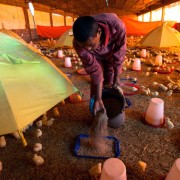
Comment
Make a general inquiry or suggest an improvement.